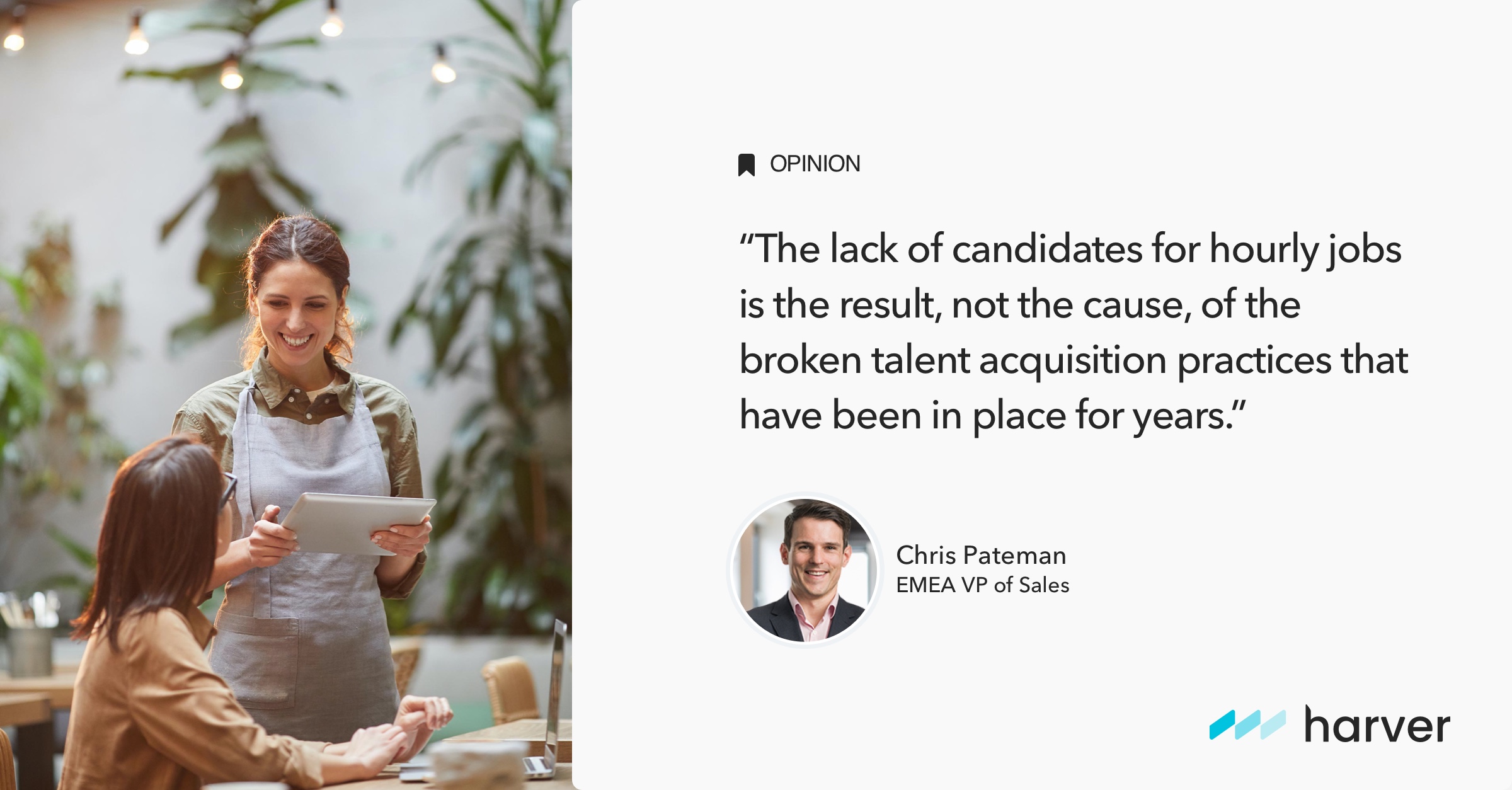For the first time since 2008, volume is missing from high-volume hiring, leaving most organizations using traditional recruitment strategies unprepared. That’s because their processes were designed to cope with high volumes of applications, and without those large numbers, such processes no longer work well.
As a result, employers are now having to quickly adapt to the current situation — with no true guideline for doing it the right way.
Companies are consequently increasing wages, offering sign-on bonuses, and covering tuition fees in a bid to get candidates through the door and to keep hold of current employees. And yet, all over the world, the talent pools for hourly roles continue to dry up. On top of that, the end of the Great Resignation isn’t yet in sight.
Having processed over 7 million job applications since the start of the pandemic, we dare say that the hourly hiring crisis is a process, not a people, problem.
Sure, organizations worldwide are struggling to attract and retain employees. But that’s not because there aren’t enough potential candidates. It’s because high-volume hiring processes are not built to adapt to fluctuating numbers, and because they rely on outdated practices and tech stacks that were put together haphazardly, without the big picture in mind.
All of which leads to two questions: What can organizations do to fix this? And where should they start?
People still want to work — just not for you
According to preliminary data from the U.S. Bureau of Labor Statistics, in September there were 147 million nonfarm employees, the highest number since the beginning of the pandemic. Additionally, unemployment continues to decrease, with 7.7 million unemployed people, of which 4.5 million want to work and are looking for a job.
Despite the job gains made by the hospitality, retail, and warehousing industries, many employers in these sectors are still complaining about the shortage of workers. A problem which, if we are completely fair, was not only predicted but also expected. The pandemic just accelerated this trend.
The heightened risk of contracting the virus, along with low wages, inflexible work schedules, and the increasing number of remote vacancies are all contributing to the talent crisis affecting the high-volume hiring.
But the lack of candidates for hourly jobs, which are mostly entry-level in nature, is the result, not the cause, of the broken talent acquisition practices that have been in place for years. Again, the pandemic has simply brought these issues to light.

“The lack of candidates for hourly jobs is the result, not the cause, of the broken talent acquisition practices that have been in place for years.“
— Chris Pateman, EMEA VP of Sales
So let’s try to get to the bottom of this and see why volume hiring processes fail and what organizations can do to adapt to today’s low-applicant environment — all without losing sight of what’s most important: hiring the best people to support long-term business performance.
Why high-volume hiring processes fail
In the current context, the lack of candidates at the top of the funnel seems like the most pressing problem. Yet if we look beneath the surface, we see that across industries, companies in the high-volume-hiring space are struggling with high attrition, poor-quality hires, and high drop-off rates throughout the recruitment funnel.
These problems are constant, and fixing them could put an end to the shortage of workers, as fewer people quitting means fewer seats to fill. But to treat the symptoms, you must know their cause.
“The problem is not that there aren’t enough people, but that the hiring process isn’t designed to adapt to fluctuating numbers.”
Chris Pateman
A first explanation for these issues is a flawed selection strategy. Traditionally, attraction and selection have been treated as two distinct challenges. Companies have always benefited from high volumes of candidates, so they rarely had to worry about not having enough talent to choose from.
Now, as talent pools shrink, employers realize that this approach to recruitment is deeply flawed. At the same time, they’re becoming anxious about people having more leverage over their job preferences. Translation: You can’t attract candidates unless you make your brand, workplace, and offering attractive.
Yet, the first instinct when candidate volumes are low is to increase sourcing efforts to maintain applicant levels. The career site and employer brand come under scrutiny to find ways to convince more candidates to apply. Assessments become an obstacle that needs to be removed. Then there are the organizations that revert to screening-free processes.
But there are two problems with this mindset: First, assessments should not just help you filter but should also help you find candidates you may not have otherwise considered. Secondly, selection should be viewed as a key part of attraction and engagement. Proper selection serves as a lock on your back door: Done right, it decreases attrition, thereby relieving pressure on your sourcing initiatives.
Next to the approach to selection, the lack of data to guide recruitment decisions is another reason behind broken high-volume-hiring processes. To be able to respond to unpredictable market shifts when hiring at scale, you need business-intelligence capabilities deeply integrated into your tech stack, as this enables you to generate insights on everything from your best sourcing channels to the process steps that are disengaging applicants.
So, if fixing these issues can render the candidate shortage a non-problem, where should you start?
Fixing the faulty volume hiring process
We work with a large number of retailers and restaurant chains, so we had a front-row seat to the way that Covid has irrevocably been altering high-volume hiring and forcing organizations to rethink their recruitment processes.
Something we heard time and again from customers wasn’t that they didn’t have enough candidates but that applicant levels dropped below what they were used to, and that there was pressure to keep up with hiring metrics. As a result, TA leaders started to ditch the assessments and to switch back to one-click applications.
So the problem, again, is not that there aren’t enough people, but that the hiring process is not designed to adapt to fluctuating numbers.
Selection processes, whether powered by a single recruiting platform or multiple tools, tend to be linear in how they screen out candidates. A candidate needs to meet the threshold set for each stage to progress to the next. However, in a rapidly-changing labor market, this approach sets you up for failure.
So what can you do about it?
To future-proof your hiring, you need to take a holistic approach to recruiting and move from a rigid, linear process to a flexible, agile one.
That requires focusing on the four areas where the challenges lie within high-volume-hiring processes: matching, automation, candidate experience, and business intelligence.
Matching. First, matching should help you identify the right applicants, as well as get them excited about the role. A mistake we often see in high-volume hiring is that recruiters use matching technology only to filter candidates out, when they should think of it as a tool for assessing skills, understanding skill gaps, and then matching people to available roles. This makes the process less wasteful, as you end up needing fewer candidates for filling your vacancies.
Automation. In a tight labor market, you want a process that’s quick and enables you to offer job security as fast as possible. But this doesn’t mean that when market conditions change, you should switch back to a long process that discourages candidates from applying. On the contrary, you should consider automating as many steps as possible between “Apply” and “Hire.” This reduces your team’s workload, ensuring a fast process. Especially in hourly roles, you’re competing with many other employers, so the first employer to make an offer often wins the candidate.
Candidate experience. In entry-level roles, CX is often overlooked, leaving applicants misinformed. As a result, many of them end up quitting after only a few weeks or months. To fix this, you should build an engaging application experience that reflects your employer brand and helps job-seekers learn about the business and the role before applying. You can achieve this by mixing employer videos with realistic job previews in the form of virtual job tryouts or situational judgement tests.
Business intelligence. When hiring at scale, controlling your process and having full visibility into your data is essential. You should therefore leverage data from your entire hiring funnel, so that you can easily spot bottlenecks, extract operational insights, and make data-driven decisions.
Ultimately, the solution to the current talent shortage is to take a holistic approach to high-volume hiring by building an agile, fully automated, and informative recruitment process focused not on filtering out candidates but on assessing their skills and matching them to available vacancies across locations. By doing so, you don’t need as many candidates applying, as you increase the quality of hire and lower attrition in the long run.
This article was originally published on ERE.net.

